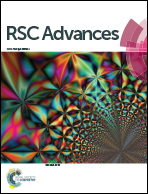In situ synthesis of copper nanoparticles within ionic liquid-in-vegetable oil microemulsions and their direct use as high efficient nanolubricants†
Abstract
The current study highlighted a simple, efficient and environmentally friendly preparation method of a new type of nanolubricant. Herein, copper nanoparticles were successfully in situ synthesized within ionic liquid-in-vegetable oil microemulsions, and the as-prepared systems could be used as high-performance nanolubricants directly. Ascorbic acid and copper chloride were used as the raw materials for the synthesis of copper nanoparticles, whereas the castor oil, 1-butyl-3-methylimidazolium tetrafluoroborate and Triton X-100 were employed for the formulation of ionic liquid microemulsions. The copper-based ionic liquid-in-vegetable oil nanolubricants were characterized by dynamic light scattering, UV-visible spectra and a four-ball tribological tester, which confirmed the formation of copper nanoparticles and the improvement of the friction performance. The SEM micrographs and EDX chemical analysis were carried out to analyze the friction surface after sliding. The results showed that the designed nanolubricants presented an enhanced lubricating property compared to the neat ionic liquid microemulsion. In addition, the mechanism of the in situ synthesis of nanoparticles within nonaqueous ionic liquid microemulsions was discussed.


 Please wait while we load your content...
Please wait while we load your content...